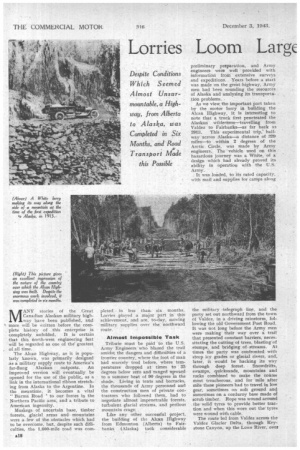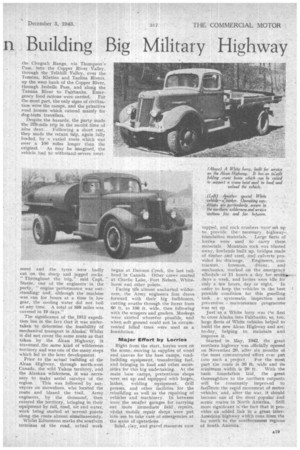Lorries Loom Large n Building Big Military Highway
Page 20

Page 21

If you've noticed an error in this article please click here to report it so we can fix it.
MANY stories of the Great Canadian Alaskan military highway have been published, and ' more will be written before the complete history of this enterprise is completely unfolded. It is certain that this north-west engineering feat will be regarded as one of the greatest
, of all time.
The Akan Highway, as it is popularly known, was primarily designed .as a military supply route to America's far-flung Alaskan outposts. An improved version will eventually be opened for the use of the public, as a link in the international ribbon stretching from Alaska to the Argentine. In the meantime, it becomes a vital " Burma Road ' to our forces in the • Northern Pacific area, and a tribute to American ingenuity. Muskegs of uncertain base, timber • forests, glacial areas and mountains were a few of the obstacles which had to be overcome, but, despite such difficulties, the I,600-mile road was corn
pleted, in less thansix Months, Lorries. iplayed a major part in this achievement, and are, to-day, moving military supplies over the northward route.
Almost Impossible Task Tribute must be paid to the U.S. Army Engineers who blazed the trail amidst the dangers and difficulties of a frontier country, where the foot of man had scarcely trod before, where temperatures dropped at times to 35 degrees below zero and ranged upward to a summer heat of 90 degrees in the shade. Living in tents and barracks, the thousands of Army personnel and the construction men of private contractors who followed them, had to
o altnost impenetrable forests, turbulent glacial streams, and perilous mountain crags..
Like any other successful project, the building of the Alcan Highway from Edmonton (Alberta) to Fairbanks (Alaska) took considerable preliminary preparation, and Army engineers were well provided with information from extensive surveys and expeditions. Years before a start was made 'on the great highway. Army men had been sounding the resources of Alaska and analysing its transportation problems. • As we view the important part taken by the motor lorry in building the Alcan Highway, it is interesting to note that a truck first penetrated the Alaskan wilderness—travelling from Valdez to Fairbanks—as far back as
1913. This experimental trip; halfway across Alaska—a distance of 379 miles—to within 2 .degrees of the Arctic Circle, was made by Army engineers. The vehicle used on this hazardous journey was a White, of a design which had already proved its ability in operation with the U.S. Army.
It was loaded, to its rated capacity, with mail and supplies for camps along the military 'telegraph line, and the party set out northward from the town of Valdez, in a driving rainstorm, following the old Government Post Road. It was not long before the Army men were making their way over a trail that presented constant barriers, necessitating the cutting of trees, blasting of stumps, and bridging of streams. At times the party was confronted with steep icy grades or glacial rivers, and, later, it would be hacking its way through deep forest. Snowdrifts, swamps, quicksands, mountains and rocks combined to make the course most treacherous, and for mile after mile these pioneers had to travel in low gear, sometimes on soft ground and sometimes on a corduroy base made of scrub timber. Rope was wound around the solid tyres to provide better traction and when this wore out the tyres were wound with cable.
The route led from Valdez across the Valdes Glacier Delta. through Keystone Canyon, up the Lowe River, over
the Chugach Range, via Thompson's Pass, into the Copper River Valley, through the Telkhill Valley, over the Tonsina, Klutina and Tazlina Rivers, up the west bank of the Copper River, through Isabelle Pass, and along the Tanana River to Fairbanks. Emergency food rations were carried. For the most part, the only signs of civilization were the camps, and the primitive road houses which catered mainly for dog-team travellers.
Despite the hazards, the party made the 379-mile trip in the record time of nine days. Following a short rest, they made the return trip, again fully loaded, by a varied route .which was over a 100 miles longer than the original. As may be imagined, the vehicle had to withstand severe treat ment and the tyres were badly cut on the sharp and jagged rocks. " Throughout the trip," said Capt. Steese, one of the engineers in the party, " engine 'perfermance, was outstanding; and, although the 'machine' was run for hours at a time in low gear, the cooling water did not boil at any time. A total of 899 miles was covered in 19 days."
The significance. of the,1913 expedition lies in the fact that it was undertaken to determine the feasibility of mechanical transport in Alaska: Whilst it did not cover the same route as that taken by the Alcan Highway, it traversed, the same kind of wilderness territory and was one of the many steps which led to the later development.
Prior to the actual tritilding of the Alcan Highway, through north-west Canada, .the wild Yukon territory, and the Alaskan Wilderness, it was nedessary to make aerial surveys of the region. •. 'This was followed' by surveyors on snowshoes, who located the route and blazed the trail. Army engineers, by the thousand, then entered the territory, bringing in their equipment by rail; road, air and water, work being started at several points along the route almost simultaneously.
Whilst Edmonton marks the scnitherri terminus of the road, actual work
began at Dawson Creek, the last railhead in Canada. Other •crewsstarted at Charlie Lake,. Fort Nelson, White
horse and other points. .
Facing th`e almost uncharted wilderness, the Army engineers first drove forward with their big bulldozers, cutting swaths through the forest from 60 ft. to 100 ft. wide, then following' with the scrapers and graders. Muskegs were skirted where0'er possible, and when soft ground could not be circumvented felled trees were used as a foundation.
Major Effort by Lorries
Right from the start, lorries were on the scene; moving in supplies of wood and canvas for the base camps, roadbuilding equipment, transferring fuel, and. bringing in food and other necessities for this big undertaking. At the main base -camps, pretentious shops were set up and equipped with forges, lathes; welding equipment, drill presses, and other facilities for the rebuilding as well as the repairing of vehicles and machinery. In between were the smaller garages for carrying out more immediate field . repairs, whilst mobile repair shops were put into use to take care of emergencies at the scene of operations.
Sand, day, and gravel resources were
tapped, and rock crushers were' set up to provide the' necessary highway-.
fOundation materials. Large fleets of lorries were . used to carry these materials. Mountain rock was blasted away, lowlands built up, bridges made of timber and steel, and culverts pro vided for drainage. Engineers, con tractors, foremen, driyee and mechanics, worked on the ernergenc+ setheclule of 7.1 hours a day for sevendays a week, and lorries were idle for only a: few hours,day or night.
order to keep the vehicles in the best possible -condition for this gruelling
task, a systematic inspection and preventive maintenance programme was set up.
Just-as a White lorry was the first to cross Alaska into Fairbanks, so, too, large fleets of White vehicles helped to build the new Alcan Highway and are; to-day, helping , to maintain and improve it.
Started in May, 1942, the great northern highway was officially opened on November 20, after six months of
the most concentrated effort ever put
into such a project. For the most part the route is 36 ft. wide and its minimum width is 20 ft. With the basic foundation laid, the great thoroughfare to the northern outposts
will be • constantly improved to facilitate the rapid movement of motor
vehicles, and, after the war, it should become one of the most popular and scenic routes in North America. Still
more significant isthe fact that it provides an added link in a great interAmerican" highway Which runs from the far north to the saiithernmest regions, of Smith Anierital




















































